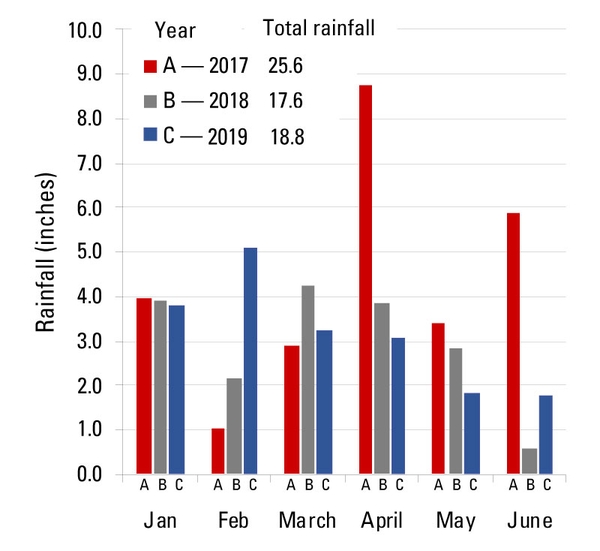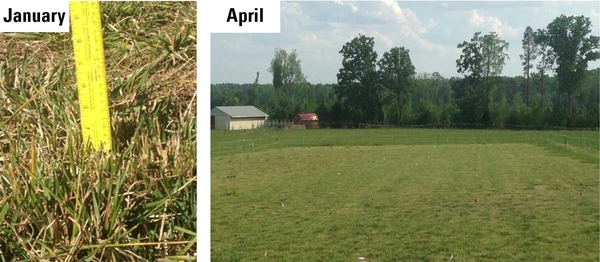Annual and perennial clovers can be successfully frost-seeded into tall fescue pastures in the piedmont of North Carolina.
Introduction
Tall fescue-clover mixtures have a long history of improving livestock performance in the U.S. transition zone (Thompson 1993; McMurphy, et al. 1990) and mitigating the effects of fescue toxicosis (Aiken, et al. 2016; Harlow, et al. 2022). In addition, tall fescue-clover mixtures can improve the food supply for flower-visiting pollinators (Harris and Ratnieks 2022; Hanley, et al. 2008) (Figure 1). This publication discusses the practice of frost-seeding clovers into established tall fescue pastures and presents the results of research conducted in the North Carolina piedmont. The data for this publication come from research conducted by the Forage and Grassland Program at North Carolina State University that evaluated five planting rates for five clovers that were frost-seeded into established tall fescue pastures for three years (Castillo, Bekewe and Rivera 2022).
What is Frost-Seeding?
Frost-seeding is the practice of broadcasting clover seed in winter so that freeze-thaw cycles of the soil surface, coupled with late-season rainfall, favor seed penetration in the soil and provide adequate soil-seed contact (Hall, Newman and Williamson 2020), resulting in successful establishment of clovers and a tall fescue-clover mixture.
Purposes and Benefits of Frost-Seeding Clovers into Tall Fescue Pastures
Frost-seeding is a low-cost, low-disturbance strategy to introduce clovers into established tall fescue pastures with the goal of creating tall fescue-clover mixtures. There are multiple and well-documented benefits that tall fescue-clover pastures provide over monoculture tall fescue pastures, including the following:
- Clovers improve the nutritive value (crude protein and energy) of the forage grazed by livestock (Rayburn, Blaser, and Fontenot 1980; Chapman, Parsons, and Schwinning 1996) and provide food supply for flower-visiting pollinators (Harris and Ratnieks 2022; Hanley, et al. 2008).
- Clovers can reduce the need for N fertilizer inputs by fixing atmospheric nitrogen (N), which later becomes available to sustain the grazing system (Gatiboni and Reberg-Horton 2021; Schwinning and Parsons 2016).
- 20% to 40% clover in spring pastures and 10% in summer pastures improves livestock responses (for example, weight gains of beef steers) (Thompson 1993; McMurphy, et al. 1990) and alleviates chronic signs of tall fescue toxicosis (Aiken, et al. 2016, Harlow, et al. 2022).
Critical Steps when Frost-Seeding Clovers into Tall Fescue Pastures
Initial Evaluation of Tall Fescue Pastures
Pastures to be frost-seeded should be evaluated at least one year (ideally) in advance. The evaluation should include soil testing and weed pressure. Doing so will allow enough time to apply lime to correct the soil pH, if needed. Legumes and the N-fixation process are particularly sensitive to soil pH, requiring a pH level between 6 and 6.5. Fertilizer recommendations should be soil-test based.
If there is pressure from winter weeds, then identify the weed species and an appropriate herbicide program. Weed pressure can hinder clover establishment due to competition for resources (such as light, soil nutrients, and soil moisture). Weeds like buttercup, musk thistle, and buckhorn plantain, can be selectively controlled with fall or spring applications using postemergence herbicides with the active ingredient 2,4-D. Note that the herbicides should be used in the seasons prior to when clovers are frost-seeded.
Frost-Seeding Dates
Variable weather patterns require that land managers continuously monitor soil moisture and weather at the specific field level to make the best possible decision to start field operations. It is impossible to pinpoint a single calendar date that ensures successful establishment of forages. A range of generally considered “best dates” for establishing forages in North Carolina are provided in the Extension publication Planting Guide for Forage Crops in North Carolina. For three years of experimentation in the North Carolina piedmont (2017, 2018, and 2019), frost-seeding clovers was successful when the seed was broadcasted between early and mid-February, specifically between the dates of February 8 and 18 (Table 1). Detailed records of absolute maximum and minimum monthly temperatures and cumulative rainfall during the January-to-June experimental period are presented in Figure 2a and Figure 2b.
Control of Competition from the Grass Component
In preparation for frost-seeding clovers, the grass component should be clipped (and the clipped herbage removed from the pasture) or grazed to a stubble height of 2 to 3 inches. Frost-seeding can be achieved by broadcasting the seed (Figure 3). The process of broadcasting the clover seed can be accomplished by hand or by using spreaders.
During the establishment phase, both the clover and grass components should be monitored, and the grass component should be frequently defoliated to the height of the emerging clovers (Figure 4a and Figure 4b). This approach allows for control of competition from tall fescue and favors continuous sunlight penetration to encourage establishment of the young clover seedlings (Tracy and Schlueter 2010; Tracy, Schlueter, and Flores 2015). Between the planting date in February until harvest in late May or early June in the piedmont, tall fescue was defoliated once. See details in Table 1 as an example of the dates when activities occurred during three different years in the piedmont.
Planting Rates
Recommended planting rates for frost-seeding ball, crimson, red, and white clovers in the piedmont are 5, 18, 10 and 5 lb/acre, respectively, on a pure live seed basis. An online calculator to estimate pure live seed rates is available in the Planting Guide for Forage Crops in North Carolina. It is worth noting that available seed of clover in the market is nowadays most likely coated and the coating can account for a wide range of the bulk weight of the seed. For this trial specifically, seed coatings accounted for 30% to 50% of the bulk seed weight.
Pasture Productivity and Nutritive Value
Frost-seeded clovers in tall fescue pastures accounted for 27%, 35%, 23%, and 11% for ball, crimson, red, and white clovers, respectively, of the total herbage mass in the late-May-to-early-June sampling event (Table 2). Frost-seeding clovers into tall fescue pastures resulted in noticeably lower weed infestation (other plants different than tall fescue and the clovers) compared to the tall fescue plots with no clovers. Greater total herbage mass was not necessarily observed because of frost-seeding clovers into tall fescue pastures.
Frost-seeding clovers in tall fescue pastures increased crude protein (CP) and total digestible nutrient (TDN) concentrations of the harvested forage (Table 2). However, the improvement in nutritive value was marginal in this case. It is worth noting that compared to the values required to meet the dietary needs of a lactating beef cow in the first 90 days after calving if forage was the only source of feed (10.5% CP and 60% TDN), the CP and TDN concentrations of the grass component alone met these requirements.
Data from 12 independent tall fescue grazing trials in the US tall fescue belt was previously summarized (Thompson et al. 1993). The authors indicated that when the clover component represented at least 20% to 40% of the herbage mass in spring and 10% in summer pastures, daily weight gains of beef steers were at least 10% greater on high-endophyte (50% to 97% infestation) tall fescue-clover mixtures, and about 20% greater on low-endophyte (≤ 5% infestation) tall fescue-clover mixtures, compared to monoculture tall fescue pastures.
Ball, crimson, red, and white clovers can be successfully frost-seeded into tall fescue pastures as a strategy to create a grass-legume mixture to improve pasture and livestock responses, as well as to support pollinators, increase N cycling and reduce weed infestation.
References
Aiken, G. E., M. D. Flythe, I. A. Kagan, H. Ji, and L. P. Bush. 2016. "Mitigation of Ergot Vasoconstriction by Clover Isoflavones in Goats (Capra hircus)." Frontiers in Veterinary Science 3. ↲
Castillo, M. S., P. E. Bekewe, and E. & R. Rivera. 2022. "Clover Frost-Seeding Rate Effects on Productivity and Nutritive Value of Tall Fescue Pastures During the Year of Establishment." Crop Science 62: 1394–1403. ↲
Chapman, D., A. Parsons, and S. Schwinning. 1996. "Management of Clover in Grazed Pastures: Expectations, Limitations and Opportunities." Special Publication, Agronomy Society Of New Zealand: 55–64. ↲
Gatiboni, L. C., and S. C. Reberg-Horton. 2021. Winter Annual Cover Crops. AG-439-58. Raleigh, NC: NC State Extension. ↲
Hall, M. H., Y. C. Newman, and J. A. Williamson. 2020. Forage Establishment and Renovation. Edited by K. J. Moore, M. Collins, C. J. Nelson and D. D. Redfearn. John Wiley & Sons, Ltd. doi:10.1002/9781119436669.ch25. ↲
Hanley, M. E., M. Franco, S. Pichon, B. Darvill, and D. Goulson. 2008. "Breeding System, Pollinator Choice and Variation in Pollen Quality in British Herbaceous Plants." Functional Ecology 22: 592–598. ↲
Harlow, B. E., M. D. Flythe, J. P. Goodman, H. Ji, and G. E. Aiken. 2022. "Isoflavone Containing Legumes Mitigate Ergot Alkaloid-Induced Vasoconstriction in Goats (Capra hircus)." Animals 12: 750. ↲
Harris, C., and F. L. W. Ratnieks. 2022. "Clover in Agriculture: Combined Benefits for Bees, Environment, and Farmer." Journal of Insect Conservation 26: 339–357. ↲
McMurphy, W. E., K. S. Lusby, S. C. Smith, S. H. Muntz, and C. A. Strasia. 1990. "Steer Performance on Tall Fescue Pasture." Journal of Production Agriculture 3: 100. ↲
Rayburn, E. B., R. E. Blaser, and J. P. Fontenot. 1980. "In Vivo Quality of Tall Fescue as Influenced by Season, Legumes, Age, and Canopy Strata." Agronomy Journal 72: 872–876. ↲
Schwinning, S., and A. Parsons. 2016. "Analysis of the Coexistence Mechanisms for Grasses and Legumes in Grazing Systems." Journal of Ecology 799–813. ↲
Thompson, R. W. et al. 1993. "Combined Analysis of Tall Fescue Steer Grazing Studies in the Eastern United States." Journal of Animal Science 71: 1940–1946. ↲
Tracy, B. F., D. H. Schlueter, and J. P. Flores. 2015. "Conditions that Favor Clover Establishment in Permanent Grass Swards." Grassland Science 61: 31–40. ↲
Tracy, B., and D. Schlueter. 2010. Winter Seeding Methods to Establish Clover in Permanent Pasture. Virginia Cooperative Extension Publications. ↲
Publication date: Feb. 9, 2024
AG-960
N.C. Cooperative Extension prohibits discrimination and harassment regardless of age, color, disability, family and marital status, gender identity, national origin, political beliefs, race, religion, sex (including pregnancy), sexual orientation and veteran status.






